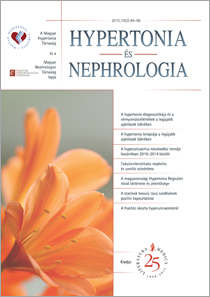The eLitMed.hu medical portal uses computer cookies for convenient operation. Detailed information can be found in the Cookie-policy.
Hypertension and nephrology - 2015;19(02)
Content
[Diagnosis of hypertension and target levels in mirror of the newest recommendations]
[In the past year, many societies published new recommendations in the field of hypertension. The European Society of Hypertension and the European Society of Cardiology (ESH/ESC) published a comprehensive guideline in July 2013, providing an elaborate description of the diagnosis of hypertension. The clinical practice guideline of the American Society of Hypertension and the International Society of Hy per - tension (ASH/ISH) contains a brief set of recommendations, and explains the diagnostic approach to hypertension in a less detailed manner. The Eighth Joint National Committee (JNC8) focuses on certain aspects of hypertension using rigorous evidence- based methodology. This article displays some of the corresponding and disparate recommendations of the three guidelines.]
[Therapy of hypertension in mirror of the newest recommendations]
[Hypertension guidelines published by various societies in the previous year follow two distinct trends regarding recommendations about treatment. The European Society of Hypertension and the European Society of Cardiology (ESH/ESC) gives the clinician free hand to select the antihypertensive drug, mentioning the optimal treatment regime for various associated clinical conditions. Guidelines published by the American Society of Hypertension and the International Society of Hypertension (ASH/ISH) or by the Eighth Joint National Committee (JNC8) are far less permissive, recommend the first drug of choice from a narrower circle of antihypertensive agents and describe the initiation and escalation of therapy in algorithms. This article displays some of the corresponding and disparate recommendations of the three guidelines.]
[Tubulointerstitial nephritis and uveitis syndrome]
[Tubulointerstitial nephritis and uveitis (TINU) syndrome is a rare and underdiagnosed oculorenal disorder that is characterized by the development of acute tubulointerstitial nephritis and uveitis. The median age of onset is 15 years, but it may occur at any age. There is a female predominance. Uveitis might occur before, after, and also concomitantly with tubulointerstitial nephritis. The symptoms are typically non-specific, including fever, loss of appetite, weight loss, nausea and vomiting, weakness, abdominal pain, arthralgias and myalgias. Laboratory findings reveal an acute impairment of renal function, anaemia and elevated inflammatory parameters. Urinary findings are consistent with tubulointerstitial nephritis including subnephrotic proteinuria, sterile leucocyturia, microhaematuria, and tubular dysfunction (e.g. normoglycemic glycosuria). The prognosis appears to be good, especially in children. Persistent renal dysfunction only develops in a small proportion of cases. In this paper, we present the case of a 39-year-old female patient with TINU syndrome, and review the literature.]
[Fructose-induced hyperuricaemia]
[The consumption of fructose and fructose-based sweeteners has dramatically increased in the last hundred years and correlates epidemiologically with the rising prevalence of obesity, hypertension and metabolic syndrome worldwide. The administration of fructose to animals and humans increases uric acid generation independently from excessive caloric intake. Fructose ingestion may also be a risk factor of chronic kidney disease, that includes glomerular hypertension, vascular alterations (arteriolosclerosis) and albuminuria. The discovery that fructose-mediated generation of uric acid may have a casual role in metabolic syndrome and kidney disease provides new insight into pathogenesis and therapies for these important diseases.]
1.
Clinical Neuroscience
Is there any difference in mortality rates of atrial fibrillation detected before or after ischemic stroke?2.
Clinical Neuroscience
Factors influencing the level of stigma in Parkinson’s disease in western Turkey3.
Clinical Neuroscience
Neuropathic pain and mood disorders in earthquake survivors with peripheral nerve injuries4.
Journal of Nursing Theory and Practice
[Correlations of Sarcopenia, Frailty, Falls and Social Isolation – A Literature Review in the Light of Swedish Statistics]5.
Clinical Neuroscience
[Comparison of pain intensity measurements among patients with low-back pain]1.
Clinical Neuroscience Proceedings
[A Magyar Stroke Társaság XVIII. Kongresszusa és a Magyar Neuroszonológiai Társaság XV. Konferenciája. Absztraktfüzet]2.
3.
Journal of Nursing Theory and Practice
[A selection of the entries submitted to the literary contest "Honorable mission: the joys and challenges of our profession" ]4.
Journal of Nursing Theory and Practice
[End of Life and Palliative Care of Newborns in the Nursing Context]5.
Journal of Nursing Theory and Practice
[Aspects of Occupational Health Nursing for Incurable Patients ]


